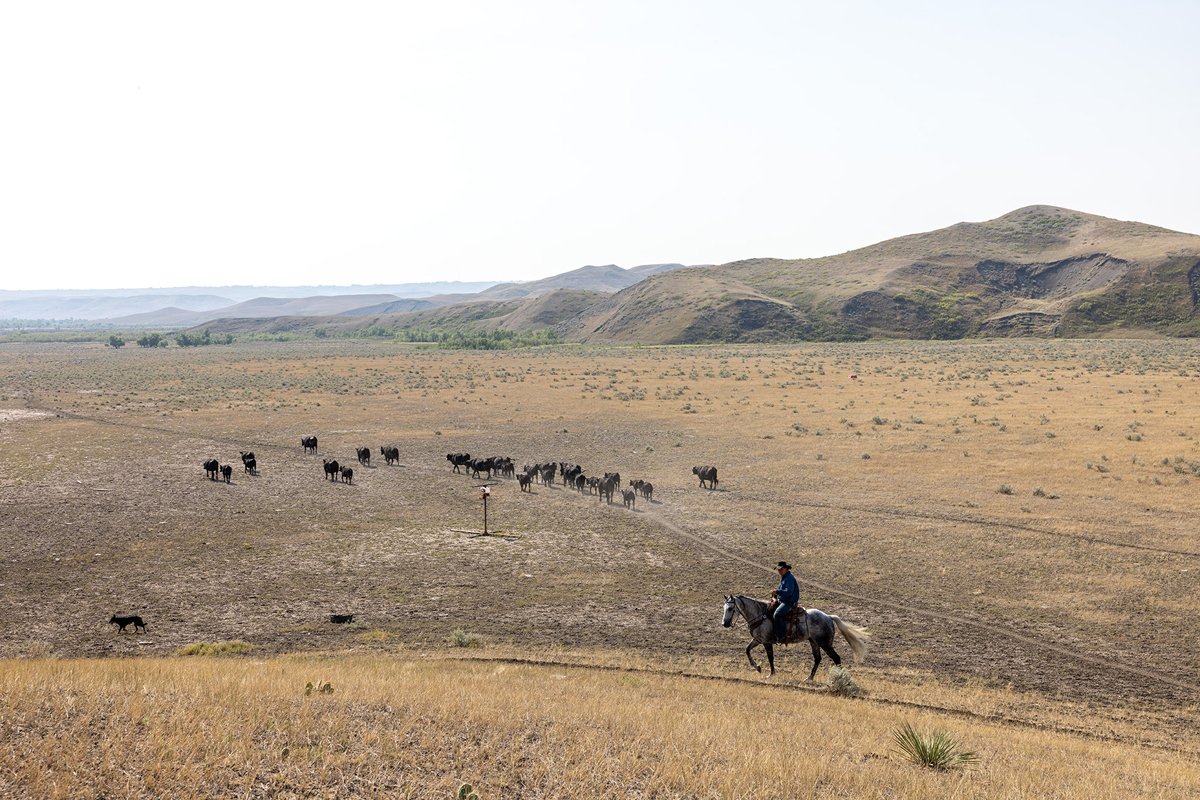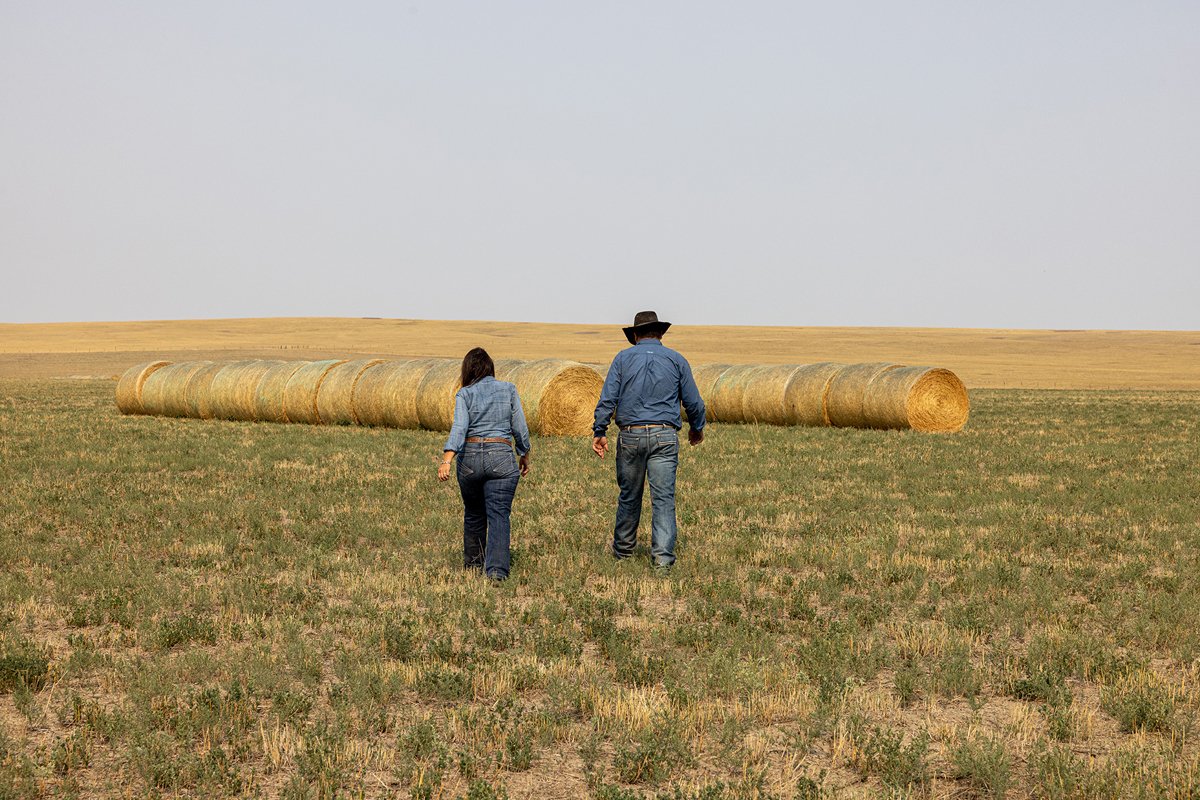A unique three-year project from the Environmental Defense Fund and the Intertribal Agriculture Council hopes to yield quantitative data about the costs and benefits of regenerative practices.

A unique three-year project from the Environmental Defense Fund and the Intertribal Agriculture Council hopes to yield quantitative data about the costs and benefits of regenerative practices.
November 20, 2023

Jess Brewer gathers livestock at Brewer Ranch on the Cheyenne River Sioux Reservation. (Photo courtesy of Intertribal Agriculture Council, www.indianag.org)
For three generations, Fanny Brewer’s family has been ranching the same land in South Dakota’s Ziebach County. Encompassing part of the 1.4-million-acre Cheyenne River Sioux Reservation, where she grew up, the county is among the poorest areas in the United States. But for Brewer, her husband, and their four kids, it represents prosperity.
The Brewers run cattle and grow some alfalfa across 12,000 acres of grassland that’s a combination of owned land, leased tribal land, and federal trust land. This complicated arrangement isn’t unusual for Indigenous producers, who experience unique hurdles such as financial lending discrimination, limited land ownership opportunities, additional governance requirements, and disproportionately high poverty rates as a result of colonialism.
“Some Native families never develop that generational wealth, whereas our non-Native neighbor, whose family has owned their land since the late 1800s, has been able to grow their business.”
Despite these systemic obstacles, the Brewers plant cover crops between alfalfa rotations and use fewer chemicals on their crops than most conventional operations. They’d like to use more regenerative ranching practices, including adaptive, multi-paddock grazing, on more land and help prove that those practices are worth investing in.
For those reasons, the ranch is one of 14 operations participating in a three-year study from the Environmental Defense Fund (EDF) and the Intertribal Agriculture Council (IAC) that is examining the benefits and barriers of regenerative agriculture among Indigenous ranchers and farmers in North Dakota, South Dakota, Nebraska, and Montana.
“The volatility of leasing land and how it affects your borrowing power with banks has always been a struggle for Native producers,” says Brewer, who also serves as the IAC’s Great Plains technical assistance specialist. “Some Native families never develop that generational wealth, whereas our non-Native neighbor, whose family has owned their land since the late 1800s, has been able to grow their business. Those are the hard realities we have to face.”
She points to a recent example when a desirable plot of land came up for sale. Compared to a local non-Native rancher who could leverage her owned land and secure a bank loan quickly to purchase that real estate, Brewer needed to put up her livestock, machinery, and other material assets as collateral since her family doesn’t own all their land—and it took weeks to assess.
“I don’t hold anything against her, but I didn’t realize until then how differently we approach things,” Brewer says. “At that time, I chose to pull out some of our land that was in trust with the U.S. government and put it in deed status so that the next time I walk into the bank, I have more power. Some people have questioned my moves, but these are choices I have had to make for my family so we can take control of our own destiny.”
This is an all too common experience among Indigenous entrepreneurs, says Skya Ducheneaux, also a member of the Cheyenne River Sioux Tribe and the founder of the Native-focused community development financial institution (CDFI) Akiptan. “Many Native producers aren’t able to list their land on their balance sheet, so they can’t leverage that value,” she explains. “When you don’t have as much equity to leverage, lending institutions deem you risky, and because of that, you get shorter repayment terms and higher interest rates. You end up stuck in this cycle of just surviving.”
Regenerative practices—most of which are already in Indigenous farmers’ and ranchers’ wheelhouses because they align more closely with, and are often based upon, their traditional practices—are much harder to employ because they’re more expensive and labor-intensive.
Brewer chose to participate in the EDF/IAC study because it will yield quantitative data about both those costs—including financial investments and loan terms—as well as the benefits of investing in regenerative practices, such as profitability, soil health improvement, forage quality, and livestock growth. To gather that information, the pilot cohort is receiving technical assistance from the IAC team and participating in the Minnesota Farm Business Management Program. Offered through the Minnesota State Colleges and Universities system, it provides one-on-one financial education such as record keeping and performance analysis.

Fanny Brewer, IAC technical assistance specialist for the Great Plains region, discusses the regenerative agriculture projects with Jess Brewer. (Photo courtesy of Intertribal Agriculture Council, www.indianag.org)
All of the producers in the study raise livestock, and some also grows crops. Many are in the process of transitioning from more extractive conventional methods to regenerative practices, with data being collected from 2022 through 2024. Although full results will not be available until the project’s completion, researchers are developing intermediate case studies, including one that should be released before the end of the year.
The researchers hope the study encourages producers to adopt climate-smart practices, such as using adaptive grazing, planting cover crops, and reducing tillage. The larger goal, however, is to urge financial institutions to reframe their understanding of Indigenous ranchers and farmers, who are often considered high-risk given their limited equity.
The shift to regenerative practices can take three to five years and reduce profitability by up to $40 per acre during the transition, according to recent research by the World Business Council for Sustainable Development’s One Planet Business for Biodiversity coalition. But farmers and ranchers can expect a 15 to 25 percent return on investment and profit growth by up to 120 percent in the long run, according to the study, which calls for public and private assistance to alleviate these burdens placed on the individual business owners.
While the term regenerative agriculture hasn’t yet appeared on many food labels, a whole range of interests—including corporate marketing departments and individual producers hoping to earn a higher premium—are anticipating a wider embrace of the term in the consumer market in the coming years. Simultaneously, the U.S. Department of Agriculture is investing heavily in new and existing carbon markets designed to reward growers for the carbon they store on their farms.
Although they’re not the focus of the current study, IAC Regenerative Economies Director Tomie Peterson (Cheyenne River Sioux) says, “Carbon credits are an opportunity that I would like to provide more education on to Native producers.”
Ducheneaux is optimistic that the EDF/IAC study will prompt traditional lenders to better support Indigenous entrepreneurs interested in taking up or highlighting their existing regenerative practices in ways akin to how Native-focused community development financial institutions are already doing so. “We have all this anecdotal evidence about the positive impacts of regenerative agriculture in Indian Country, but we don’t have the quantitative data that the rest of the world likes to see,” she says. “This study is really groundbreaking because it will reinforce what we already know, open the doors for even more producers, and broaden the impact across Indian Country.”
Although she too is eager to address these so-called credit deserts—which have notable overlap with tribal territories—Peterson wants to manage expectations about what this initiative can realistically accomplish. “The study is just trying to find the facts; I don’t know if we can overcome barriers,” she says candidly. That said, she is confident that the project findings will help cohort participants better understand if and how their practices are paying off and therefore make informed business decisions.
“The food system in North America has become very brittle, so a new model of agriculture that focuses on community and connection with the natural world is really important.”
This study closely aligns with the EDF’s objective to promote climate-beneficial farming practices while also helping producers prepare for and mitigate the escalating impacts of the climate crisis.
“Climate change majorly affects farmers and ranchers across the country,” says EDF Climate-Smart Agriculture Manager Vincent Gauthier. “We are focused on developing solutions that allow farmers to invest in the resilience of their farms against those weather extremes and changing conditions.”
Gauthier, Peterson, and the study leaders were very intentional in the language they chose to define the project, since regenerative agriculture is a hot-button topic within Indigenous communities, who used traditional ecological knowledge long before farmers and businesses started using terms like regenerative or organic. Gauthier explains that the team landed on a definition of regenerative they think transcends geographies and methodologies: a holistic approach to revitalizing land and the ecological system that focuses on improving soil’s ability to regenerate over time by involving the entire ecosystem, including humans and wildlife.
Farmer-researcher Jonathan Lundgren, whose grassroots 1,000 Farms Initiative is similarly aimed at studying and quantifying regenerative agricultural systems, notes that a larger paradigm shift is crucial. He underscores how vital hard data—about soil carbon, sequestration, reversal of desertification, promotion of biodiversity, increased farm resilience, and the like—is to incentivizing financial institutions to invest in producers employing practices that many of them have never seen or heard of.
“The food system in North America has become very brittle, so a new model of agriculture that focuses on community and connection with the natural world is really important,” he says.
Lundgren also sees Indigenous producers as an ideal group to receive more investment, as many already have the experience and tools to spearhead efforts to bring about a larger movement toward more regenerative practices. “Traditional Indigenous food systems have a deeper understanding of why the land and the life around them is essential to the long-term happiness and resilience of their culture and community.”

Jess Brewer walks alongside Fanny Brewer, IAC technical assistance specialist for the Great Plains region. (Photo courtesy of Intertribal Agriculture Council, www.indianag.org)
Ducheneaux and many thought leaders agree. They contend that an embrace of Indigenous knowledge is crucial in mitigating the effects of climate change in the years ahead. After all, while Native peoples comprise just 5 percent of the world’s population, they protect around 85 percent of global biodiversity.
“Native producers have been doing regenerative agriculture since time immemorial,” she affirms. “I hope there will be more research into tribal ecological knowledge so that the American agriculture industry as a whole can start to heal itself, and we can all hold ourselves to a higher standard in taking care of the land so it can in return take care of us.”
Back in South Dakota, rancher Fanny Brewer wants to help usher in that shift, but she needs the U.S. food system to provide an on-ramp to make it possible.
“I wish in this country you could make more money simply by doing the right thing—but that’s not how it’s set up,” she says. “I have four kids that I’m trying to raise, feed, and clothe, so I can’t be doing something just because I have a passion for it. I hope this study helps people see that you can do the right thing for the environment and for the health of human beings and animals and that you can still make it. You can be a good steward and still keep your head above water financially.”

October 9, 2024
In this week’s Field Report, MAHA lands on Capitol Hill, climate-friendly farm funding, and more.
October 2, 2024

October 2, 2024

October 1, 2024

September 25, 2024

September 25, 2024

September 24, 2024

Like the story?
Join the conversation.